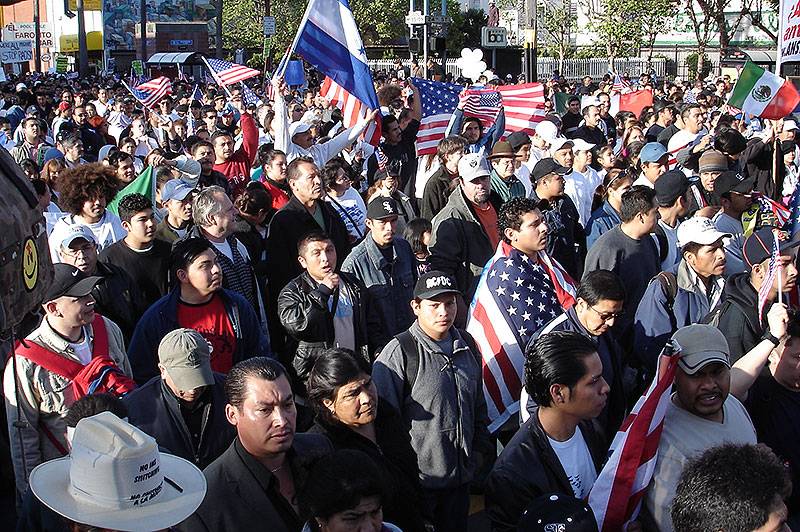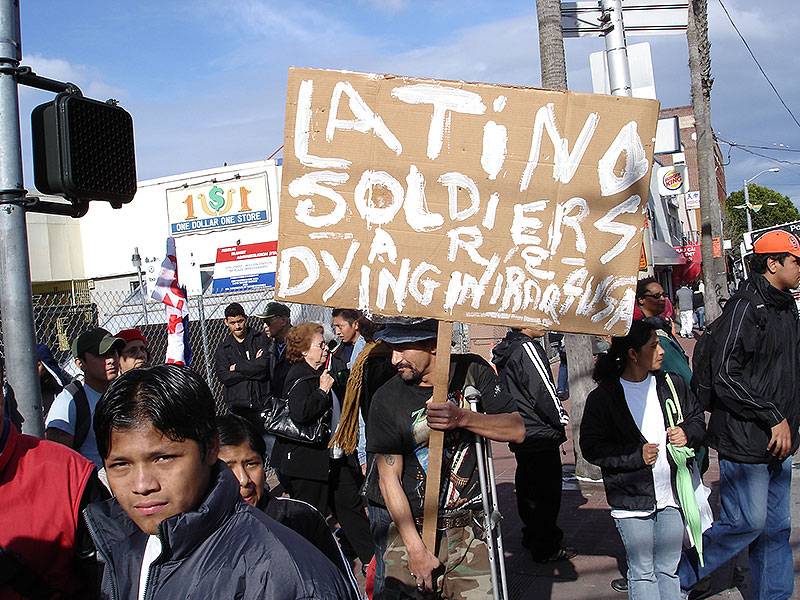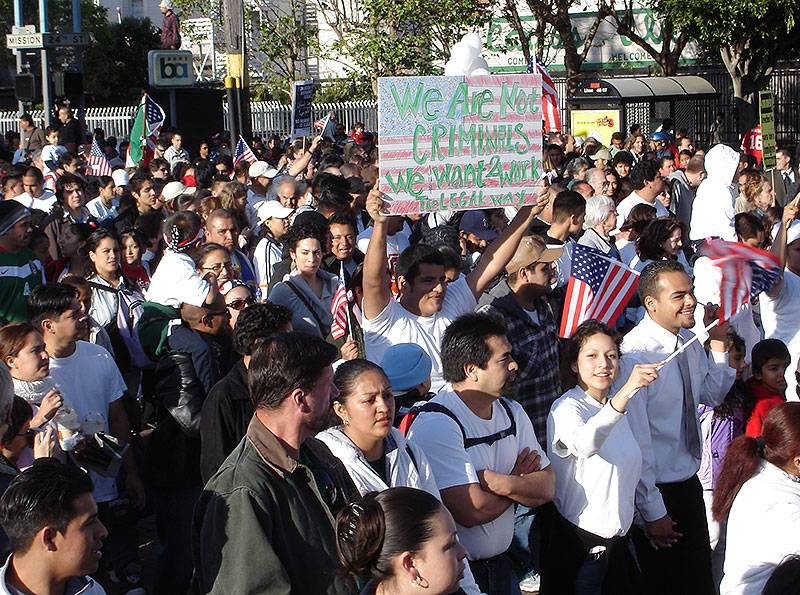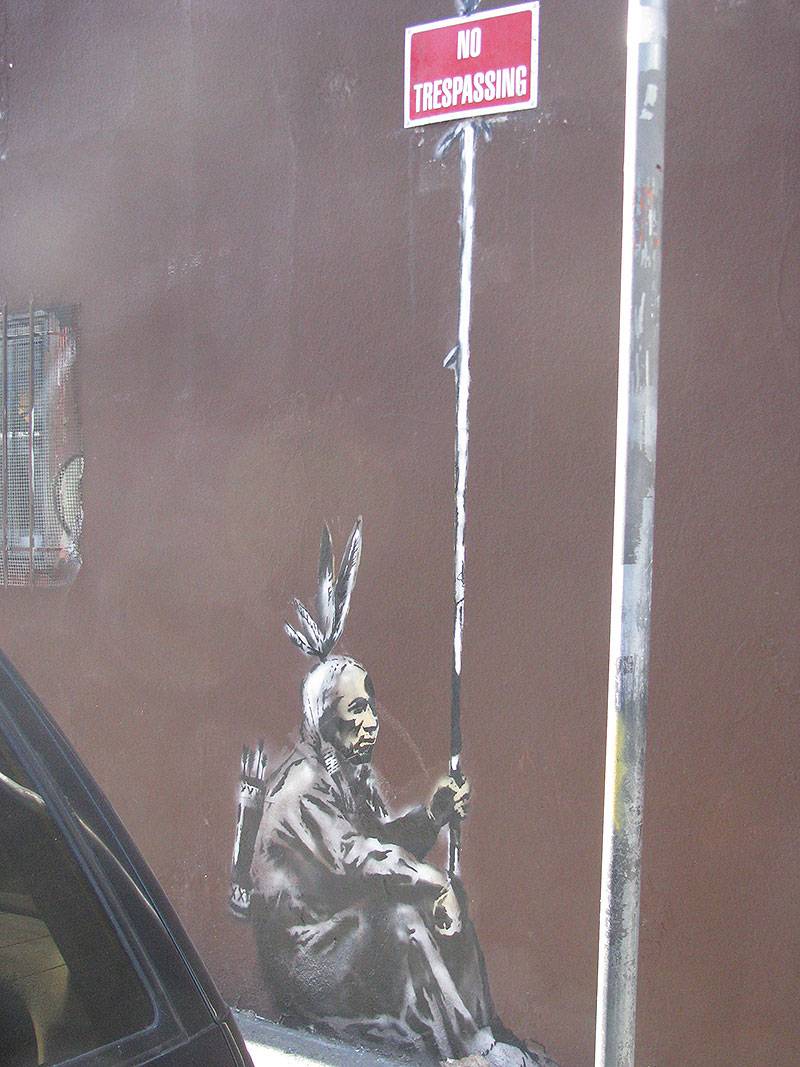La Missión and Elections
Historical Essay
by Alejandro Murguía, 2004
Originally published in The Political Edge under the title "Into the Fray," 2004
Immigrant march for amnesty at 24th and Mission, April 10, 2006.
Photo: Chris Carlsson
Democracy comes in many forms—democracies, in fact, are as varied as lizards in a pet shop. But the basic dictionary definition of democracy is a government in which supreme power is exercised by the people via elections—hence government by the people, supposedly (and why not?) for their benefit. In other words, all of us, the common people, should constitute the source of political power, determine what laws are established, and distribute our wealth for the good of society.
From its origins, our own system of democracy has maintained a rather oblique sense of participation via the people. In the United States—so arrogant about its democratic traditions—the founding fathers were suspicious about any kind of direct democracy. And during the first half of the twentieth century, the two mainstream political parties basically denied, suppressed, or intimidated the voting rights of women and ethnic groups. Hardly an example of democracy in action, qué no?
Today, for a variety of reasons, only about 40% of eligible voters actually step into the booth. The low voter turnout indicates that democracy in this country is stagnant and does not invite participation. You don’t have to be a prophet to see that neither of the two establishment parties is anxious for a more active electorate. An apathetic electorate al-lows both parties to serve corporate interests and big campaign donors. History shows that the two main parties ha-ven’t exactly been champions of participatory democracy.
Even in San Francisco, the most liberal city in the U.S., the majority of voters tend to be wealthy and upper-middle class whites, and share similar interests and world-view as the Democrat-Republican machine. But the interests of a working class Latino family in the Mission district are not the same as the interests of a wealthy family in Pacific Heights, a district that voted overwhelmingly for Democrat Gavin Newsom.
The question is not will the Democrats stand up for Latinos but rather can this city have a functioning democracy if a portion of its population is marginalized from the political process?
One way to empower the Latino community would be to invite the Democrats’ top elected officials, Representative Nancy Pelosi, and Senators Barbara Boxer and Diane Feinstein to a forum in the Mission District (something that’s never done) so there can be open debate regarding issues like the Palestinian-Israeli conflict, health care, housing, immigration, or funding for education or the arts. Such a forum would allow the Democrats to see the faces of a constituency they have ignored, and it would also make them accountable to those they claim to represent. It would also give a human face to those affected by their actions—schools falling apart, displaced families, lack of jobs, or even training in new technology. But don’t hold your breath on a community forum any time soon, because, in reality, the above named politicos speak only for the fat cats who line their campaign coffers. To paraphrase Bob Dylan “Money doesn’t talk, it swears.”
From the April 10, 2006 March for Amnesty.
Photo: Chris Carlsson
The people in La Missión, Excelsior and Bayview-Hunters Point, forgotten, ignored, and silenced for so long, also pay taxes—only they don’t get much back: their housing and schools are dilapidated and murderous violence is ram-pant. So for these marginalized neighborhoods, more estranged than ever from political power, their only hope in a democracy is grassroots candidates that will oppose the Democrat-Republican stranglehold on the city, which has been marked by corruption, deception and favoritism.
I’ve always judged the strength of a democracy not by how much money candidates raise for their campaigns, nor by which of the two almost identical parties poll the most votes, but by how amply involved are the people in elections. In October and November 2003, during the Matt Gonzalez campaign for mayor of San Francisco, the spontaneous participation of a varied cross-section of people was like a fresh breeze blowing through a South of Market alley. For the first time in decades, people who’d been left out of the electoral process or who’d been ignored by machine politics suddenly became involved in a campaign that pitted a long-shot underdog against the most formidable party ma-chine ever assembled in San Francisco.
Especially heartening was the participation of artists and writers, reminiscent of other popular movements in this hemisphere. In 1970 the Chilean Unidad Popular movement of Salvador Allende, was strongly supported by poet Pablo Neruda and other Chilean artists and writers. Jamaican prime minister Michael Manley was actively supported by reggae great Bob Marley. In 1979, the early Sandinista movement in Nicaragua mobilized poets and writers such as Ernesto Cardenal, Sergio Ramirez, and Gioconda Belli.
Part of the mystique, glory, and appeal of San Francisco is its artistic-bohemian aura and milieu. The participation of so many marginalized groups, especially neighborhood artists and writers in November 2003, was a powerful challenge to the Democratic machine, which under Willie Brown had left many people despairing, including myself, of ever again having a reason to vote. The Democratic Party candidate for mayor, Gavin Newsom, donated money to the George W. Bush/Republican Party campaign for president! I mean—how much closer can their interests be aligned?
The spontaneous energy created by volunteers in the Gonzalez campaign even evoked memories of the Civil Rights movement of the 1950s and 1960s. Marginalized people of color forced open the doors of the political process, not because a party organized them but because they felt the urge to change a system that had very deliberately left them out (although the same system never hesitates to tax or draft these citizens for its wars).
What appeared as a fresh breeze for the previously marginalized electorate was interpreted by the Democratic Party machine as a storm warning aimed at its interests. The party machine used all its power to turn back this popular movement by doing what the Republicans do. Boxer, Feinstein and Pelosi, as well as other Democrats, sent out desperate campaign literature to warn that electing a Green candidate would ruin the city. In a dirty trick to discredit them, Gonzalez campaigners were told by Newsom people to protest Al Gore’s public appearance in town. Voter registration rolls included dead people; illegal (not to mention unethical) pressure was placed on employees by city department heads to vote Democrat; and the Elections Department gave the wrong date on which absentee ballots would be mailed out, so that absentee voters began casting votes before Gonzalez campaign mailers with information about his platform could be sent out. The Democrats won the election, not on election day—that count went to Gonzalez by ten thousand votes—but because of absentee ballots. The Democrats didn’t crush the popular sentiment, but running scared in San Francisco, they employed all the tricks of the party machine to win the mayoralty for Newsom.
The people who came out for Matt Gonzalez did so precisely because they are fed up not with democracy but with a two-horse race. Considering that the Gonzalez campaign was a late starter and relied on volunteers (whereas the Democrat mayoral candidate had been running for two years), had the full backing of the political machine that has controlled San Francisco for decades (even bringing in former President Bill Clinton), and spent more per vote than any other previous candidate for mayor—considering all this, it is staggering that the Democrats had such a thin mar-gin, showing just how vulnerable they are. It also shows the untapped strength of the marginalized electorate.
That the Democrats have lost touch with what is called “the street” is obvious in other areas as well. During the massive demonstrations in San Francisco against the impending war in Iraq, none of the top three Democratic Party politicos (Pelosi, Boxer, and Feinstein) even acknowledged that over 60,000 people were marching in the streets of San Francisco. Correct me if I’m wrong, but I didn’t see Mayor Brown (a Democrat, no less, who criticized the public outrage against the war), nor his hand-picked candidate for mayor, either attend or acknowledge the people’s opposition to the Iraq war.
So how will the people have their voice and concerns heard? For many, including myself, playing the Democratic-Republican game is just falling into the wishful thinking trap. The other alternative is to open up the game, encourage more participation not less, but independent of the two parties.
I was very encouraged by how marginalized folks jumped into the fray, using their own inventiveness and spontaneity to challenge the entrenched powers-that-be. Never before in my thirty years of living in the city have artists, writers, working people, and local denizens come out in such force. I saw people riding on bikes plastered with “Matt for Mayor” posters. Districts like the Mission and the Haight turned out in force to vote for someone who would repre-sent them. Windows in many neighborhoods sported Matt Gonzalez posters for months after the election. It’s true that Matt Gonzalez didn’t win, but the November election was not about an individual anyway. It was about the common people making an effort to take back their government. The election was a moral victory in the sense of people standing up to the arrogant, party machine that thought it could buy the election the way it has always bought elections—with false promises, fear-mongering, and big money from corporate interests. It was a political victory for the common people in the sense that we had an opportunity to flex our political-electoral muscles. The real test, though, will be in future elections.
How do we stay outside the bogus two-party system, but still participate in the game? It is best to start small—there’s really no other choice. Local neighborhood activists—especially in those areas traditionally ignored by the machine, like La Missión, the Outer Mission, the Haight, and Bayview-Hunters Point should run as independents against the Democrats. And they should form alliances with all those the Democrat-Republican machines have ignored: artists, writers, and working-people, as well as with the Green Party and other small political parties. Seek advice or en-dorsements from progressive politicians like Art Agnos, one of the few Democrats to back Gonzalez. Challenge the status quo in every election, from the board of education right on up to the seat in the House of Representatives, currently held (ho hum) by a Democrat.
Perhaps with candidates that are more conscientious, we can have a more humane approach to some important issues. A favorite pet peeve of both Democrats and Republicans is undocumented immigration. But the flood of undocumented workers is caused by U.S. policy toward Latin America, a policy that follows an interventionist, “let’s over-throw the government and set up a dictatorship” model. But the politicos want it both ways—destabilize a country, then bash those who flee the chaos. Invariably the refugees come from countries we have attacked, invaded, or embargoed—Nicaragua, El Salvador, Guatemala, Cuba. They also come from those places we have trampled over economically—the northern border of Mexico is an example, which we have ruined with maquiladoras. It’s the classic imperialist-colonist blowback. In fact, Haiti and Nicaragua, the two poorest countries in the hemisphere, provide lots of undocumented immigrants. They also have the distinction of being the two countries most intervened in and meddled with by the U.S. in the last hundred years. Coming here, even undocumented, is the only way many people can survive the conditions the U.S. has imposed on their countries.
We need, at a national and local level, a noninterventionist attitude toward the rest of the continent. That doesn’t mean a let’s-hide-our-head-in-the-sand attitude à la Gavin Newsom (“I don’t care what happens in Colombia”). The San Francisco tourist industry survives on the back of immigrants, documented or not. Practically every manual job in a hotel, restaurant, or tourist joint is held by an immigrant or person of color. Immigrants do it all in this city, from washing cars to teaching law, practicing surgery to making pan dulce. A politician that attacks immigrants is what in Spanish we call un farzante, a braggart and a fraud.
Amnesty marchers at 24th and Mission, April 10, 2006.
Photo: Chris Carlsson
Latin American countries have long recognized the economic power of their immigrants and are now acknowledging their political power too. Mexico, for example, is considering legislation to permit Mexicans in the U.S. to vote in Mexican elections. Nicaragua is considering the same. Why not empower the immigrant community of La Missión to participate in local elections?
We need neighborhood political action groups that will develop priorities and leadership. Neighborhood activism in La Missión goes as far back as I can remember to the days of the Mission Coalition Organization in the mid-1960s, and the arts groups that founded Galeria de la Raza and the Mission Cultural Center for Latino Arts. A new generation of grassroots activism could write the next chapter of the Mission District, already rich with a cultural-economic-political history.
The challenge of course is to move La Missión from the margins of power to the center. So with the street conjuntos: why couldn’t we have a musicians’ plaza set up at the currently abandoned and boarded-up Taco Bell eyesore on the corner of Valencia and Mission Streets? This could provide a gathering place for these workers, similar to Plaza Garibaldi in Mexico City, famous for its mariachis; it could also serve as a hiring hall, providing a source of revenue for both workers and the City (and raise the level of professionalism among the musicians). Incorporate the street sellers on Mission Street with the concept of tianguis, mobile street markets, for the flower sellers and the paleteros and all the rest of the ambulantes.
The creative energy of La Missión could be channeled into a Centro de Artesanias, where local artisans would have a place to create and sell their wares. The long abandoned National Guard armory site at 14th and Mission could house such a center, each floor a particular craft—say furniture and other house-and-garden items, handcrafted of wood, iron, steel, fabric—whatever the artist’s instinct desires. The center could provide the more expensive tools, such as lathes or acetylene torches, and the artisans could lease the space to work and/or sell their wares. Master craftsmen and women could mentor and be given a place in the center. There could even be a cooperative for small wine production and handcrafted beers. The center provides the tanks and fermentation equipment, the rest would be up to the locals. For example, a guy on Treat Street goes to the cooperative, brings his own hops or buys them on site, rents the equipment, brews ten gallons and stores it right there, in stainless steel containers. On Sundays, for the football game, he’d pick up a gallon of his own handcrafted brewsky from the cooperative then kick back with his family and friends to enjoy. Could life be any better than that?
And La Missión, known for it rich literary and bohemian character, could host an intercontinental gathering of poets. The Mission Cultural Center for Latino Arts, along with local bookstores and literary arts centers could invite participants from all over the continent, including Cuba, Haiti, and Nicaragua, to read, dialogue, and experience our city in a week long Poetry Festival of the Americas. This festival would enrich both the coffers and ambience of the Mission, the city, and the hemisphere. How come we haven’t made this happen before?
And what about the world famous murals that first drew attention to La Missión in the early seventies? For the most part they are now neglected and in some cases have been destroyed by corporations that didn’t get it. These murals are integral to La Missión. A case in point—the Lily Ann mural by Chuy Campusano—a three-story masterpiece of abstract Chicano arté—now a whitewashed symbol of the greed and disrespect the dot.commers left us. In spite of the dot.com boom and the so-called media gulch that has overrun the northeast part of the barrio—there have been zero jobs for this community. And where were the politicians while this economic war was waged on us? The Latino community and the working-class community survived out of our own sheer will—against the desires of those who want to see us run out or made invisible. But we are here and we are not leaving.
I believe the disenfranchised Latino electorate of San Francisco has the cojones to create a prototype of a political party—similar to La Raza Unida Party of the 1970s and 1980s. If the Democrats fear the Greens or Ralph Nader, wait until Latinos organize. Then we’ll have a real horse race. Because in the last analysis, only someone from the neighborhood will stand up for the neighborhood. The error is in believing that only the rich will vote their interests.
If we as outsiders make a strong enough challenge, then sooner or later the pendulum of power must swing in our direction. We are, after all, the majority. It is our government whether we like it or not. In the classic definition of democracy the power rests in our hands. We will spend our own money on whatever we want and need: quality schools, safe neighborhoods, health care, restoration of our murals (and funding for new ones), more arts and less war, exactly what the Democrat-Republicans do not provide. (Which raises a question, perhaps for another day: If the wealthiest country in the world doesn’t provide its citizen with the basic human necessities, how is it government of, by and for the people?) Just think of the possibilities of a real government by the people—if just one B-1 bomber was scrapped from the budget, we’d have $200 million for something tangible, like a new hospital, or new schools, or new job training centers, or affordable housing. And anyone who says one less bomber makes us somehow vulnerable is a snake-oil salesman with his hand in the till.
The key lesson of the November campaign is that common people can make a difference. We can’t wait for the party machines to organize us. We have to do it ourselves, with our own energy and our own resources and our own platforms with our own candidates who have our interests in mind. We have absolutely nothing to lose since we don’t have a voice anyway—but we just might have our own future to gain.
No Trespassing on Sycamore Alley, reimagined by British artist Banksy in 2010.
Photo: Chris Carlsson
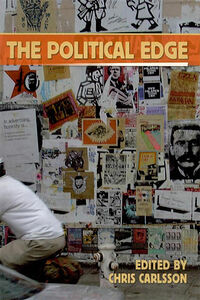
published originally in The Political Edge ed. Chris Carlsson (City Lights Foundation: 2004)

